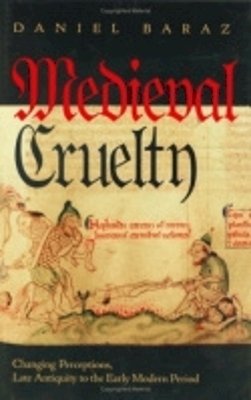
Medieval Cruelty: Changing Perceptions, Late Antiquity to the Early Modern Period
Daniel Baraz
The Middle Ages are often thought of as an era during which cruelty was a major aspect of life, a view that stems from the anti-Catholic polemics of the Reformation. Daniel Baraz makes the striking discovery that the concept of cruelty, which had been an important issue in late antiquity, received little attention in the medieval period before the thirteenth century. From that point on, interest in cruelty increased until it reached a peak late in the sixteenth century.
Medieval Cruelty's extraordinary scope ranges from the writings of Seneca to those of Montaigne and draws from sources that include the views of Western Christians, Eastern Christians, and Muslims. Baraz examines the development of the concept of cruelty in legal texts, philosophical treatises, and other works that attempt to discuss the nature of cruelty. He then considers histories, martyrdom accounts, and literary works in which cruelty is represented rather than discussed directly.
In the wake of the intellectual transformations of the twelfth and thirteenth centuries, an increasing focus on the intentions motivating an individual's acts rekindled the discussion of cruelty. Baraz shows how ethical thought and practice about cruelty, which initially focused on external forces, became a tool to differentiate internal groups and justify violence against them. This process is evident in attacks on the Jews, in the peasant rebellions of the later Middle Ages, and in the Wars of Religion.
Product Details
About Daniel Baraz
Reviews for Medieval Cruelty: Changing Perceptions, Late Antiquity to the Early Modern Period
Virginia Quarterly Review
An important and imaginative study in intellectual history, this book informs us about the use of a powerful concept over centuries and simultaneously warns against easy assumptions about correspondence between text and context.
Richard W. Kaeuper, University of Rochester
American Historical Review
For Baraz, the treatment of cruelty is a cultural issue and must be considered apart from the actual practice of violence.... His argument is sound and thoroughly convincing. Because he carefully provides the historical context for each episode that he discusses, Medieval Cruelty is suitable both for general readers and experts.
David S. Sefton, Eastern Kentucky University
History
